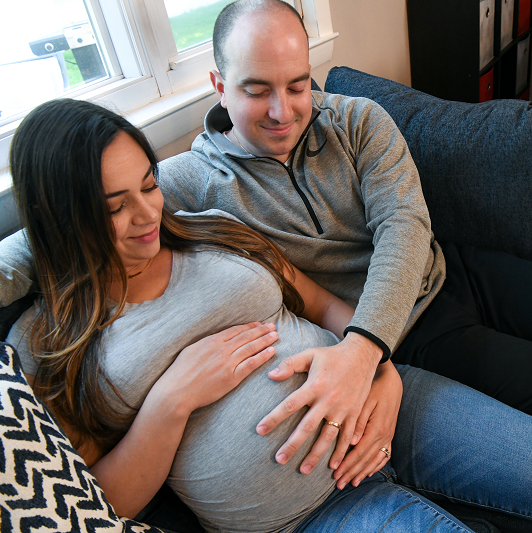Emergency Surgery Saves Pregnant Rumson Woman
October 23, 2024
Early last year, Allison Adams was thrilled to learn that she was pregnant with her third child. The Rumson, New Jersey, resident had experienced preeclampsia and postpartum preeclampsia during her previous two births, but she felt healthy and confident going into her third.
But during an early pregnancy scan, Allison’s obstetrician noticed some abnormal vascularity in the placenta.
“My doctor told me that I’d likely have to have a C-section, a hysterectomy and I’d have to deliver early at a hospital that was over an hour away,” Allison says. “I thought they were being alarmist. How could they know that so early in my pregnancy?”
Her obstetrician referred her to Jesus Alvarez-Perez, M.D., director of Maternal Fetal Medicine and the Center for Abnormal Placentation at Hackensack University Medical Center.
Unexpected Diagnosis at 16 Weeks Pregnant
At 16 weeks pregnant, Allison was diagnosed with placenta percreta, a condition that occurs when the placenta abnormally invades through the different layers of the uterine wall and can attach to nearby organs, including into the bladder or to the pelvic sidewalls that run the arteries into the legs, as in Allison’s case.
According to the National Institutes of Health, placenta percreta used to occur roughly in 1 in 2,500 pregnancies. But now its incidence is higher and thought to be as frequent as 1 in 1,000 pregnancies.
The occurrence of a placenta percreta is thought to be related to abnormalities in the lining of the uterus, often due to scarring after a C-section or other uterine surgery. Allison had two previous C-sections and two D&Cs due to miscarriage.
What made this condition particularly unique is that Allison says she felt perfectly normal, no discomfort, no pain, no symptoms whatsoever.
“I didn't feel physically different, and I didn't look physically different,” she says. “It was like nothing was going on, except everything was going on.”
Dr. Alvarez-Perez, however, told Allison that even though she felt fine, she needed to be extremely cautious.
“I couldn’t lift my two other kids. I couldn’t jump, I couldn’t run, I couldn’t walk long distances. He told me to limit the number of stairs I climbed. Once up, once down,” Allison says. “It wasn't bed rest, but it was about as close as you could get to it.”
Relocating Before Delivery
Dr. Alvarez-Perez also told Allison that, out of an abundance of caution, she and her family should consider relocating to be closer to Hackensack—she lived 90 minutes from there. Rather than risk needing a helicopter ride in case of an emergency, she packed up her family and moved into her in-laws’ house just minutes from the hospital.
Then, at 22 weeks pregnant, Allison began spotting despite her extremely limited activity. She rushed to the hospital, was treated and sent home. This happened again at 24 weeks and 26 weeks. At 28 weeks, she was admitted to the hospital, and at 30 weeks, it was time for delivery.
Life-saving Blood Transfusions
In the middle of the night, Allison had a large intra-abdominal and vaginal hemorrhage, prompting an emergency surgery. On August 5, 2023, around 2:30 a.m., baby Claire was born via C-section, and surgeons then removed Allison’s uterus via a hysterectomy.
Because she had lost so much blood before and during surgery, Allison was given several units of blood transfusions. Allison says when she woke up, she was in the surgical ICU intubated.
“We have a very robust transfusion protocol and an incredible multidisciplinary team always ready to manage a situation like this,” Dr. Alvarez-Perez says.
Allison stayed in the hospital for 10 days to recover, and baby Claire stayed in the NICU for a few weeks. But everyone is now home, happy and healthy.
“It was such a miracle that we found them, right? That we were in the right place at the right time with the right people,” Allison says. “I just have so much gratitude and admiration.”
To show her gratitude, Allison organized a fully attended charity spin ride at a local spin studio and raised $8,000 for the new Claire Adams Fund at the hospital. She plans on hosting a blood drive next.
“My life was saved by receiving someone else’s blood, so I’d like to return that favor,” she says.

Next Steps & Resources
- Meet our source: Jesus Alvarez-Perez, M.D.
- To make an appointment with a maternal fetal medicine specialist near you, call 551-996-1771 or visit our website.
- Learn more about maternal fetal medicine at Hackensack Meridian Health.
- Make a gift to the Hackensack Meridian Health Foundation.
The material provided through HealthU is intended to be used as general information only and should not replace the advice of your physician. Always consult your physician for individual care.






